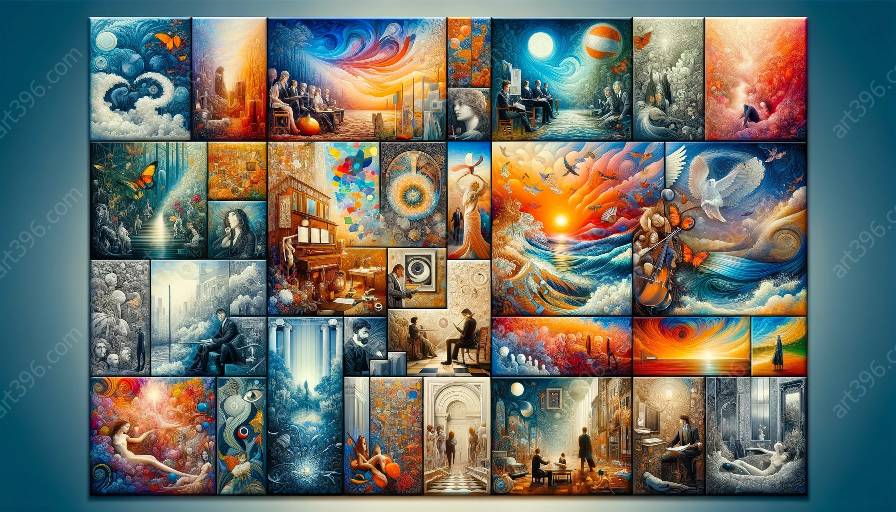Neoclassical art and Symbolism are two prominent art movements that have left an indelible mark on the history of art. While Neoclassicism sought inspiration from the classical art of ancient Greece and Rome, Symbolism embraced the ethereal and the subconscious. This article aims to delve into the historical background, key characteristics, and influential artists of these movements, as well as their compatibility with each other and their relevance to the broader context of art history.
Neoclassical Art: A Rebirth of Antiquity
Emerging in the 18th century, Neoclassicism was a reaction against the excesses of the preceding Rococo style. Inspired by the ideals of ancient Greece and Rome, Neoclassical artists sought to revive the classical art forms, emphasizing harmony, clarity, and proportion. The movement was deeply entrenched in the principles of rationality and idealism, reflecting the intellectual and political climate of the time.
Neoclassical artists often depicted scenes from ancient mythology, history, and literature, aiming to capture the noble and heroic virtues of the past. The aesthetic style of Neoclassical art was characterized by clean lines, precise draftsmanship, and a restrained color palette, evoking a sense of timeless elegance and order.
Key Figures of Neoclassicism
Among the notable figures of Neoclassical art, Jacques-Louis David stands out as a leading proponent of the movement. His iconic works, such as "The Oath of the Horatii" and "The Death of Socrates," exemplify the ideals of Neoclassical art, showcasing a harmonious blend of classical motifs and contemporary narratives.
Another influential artist of the Neoclassical era was Jean-Auguste-Dominique Ingres, celebrated for his masterful draftsmanship and classical subject matter. His paintings, including "The Grande Odalisque," epitomize the precise and refined aesthetic of Neoclassical art.
Symbolism: Unveiling the Subconscious
Emerging in the late 19th century as a reaction against the industrialization and rationality of the modern world, Symbolism embraced the enigmatic, the mystical, and the dreamlike. In contrast to the rationalism of Neoclassicism, Symbolist artists sought to explore the realms of the subconscious and the spiritual, delving into symbolism, mythology, and mysticism.
Symbolist artworks often featured elaborate symbolism and allegorical imagery, inviting viewers to decipher hidden meanings and delve into the depths of the human psyche. The movement emphasized individual expression, emotional intensity, and a departure from the constraints of objective representation.
Key Figures of Symbolism
Gustave Moreau, a prominent figure of Symbolism, created mesmerizing, otherworldly compositions that delved into mythological and biblical themes. His intricate use of symbolism and rich, symbolic imagery challenged conventional artistic norms, paving the way for the exploration of the mysterious and the esoteric.
Fernand Khnopff, another influential Symbolist artist, often portrayed haunting, enigmatic figures in surreal settings, blurring the boundaries between reality and the subconscious. His artworks, such as "I Lock my Door Upon Myself," conveyed a sense of ambiguity and introspection, encapsulating the essence of Symbolism.
Compatibility and Influence
Despite their apparent differences, Neoclassical art and Symbolism share a common thread in their pursuit of myth, symbolism, and the exploration of human experience. The classical motifs and thematic elements embraced by Neoclassical artists often resurfaced in the mystical and allegorical compositions of Symbolist painters, showcasing a seamless continuity between the two movements.
Furthermore, the emphasis on the timeless, idealized forms in Neoclassical art resonated with the Symbolists' quest for transcending the material world and delving into the ethereal realms of the psyche. This compatibility is evident in the works of artists such as Moreau and Khnopff, who seamlessly integrated elements of Neoclassical aesthetics with a profound exploration of the subjective and the symbolic.
Legacy and Relevance
The legacies of Neoclassical art and Symbolism endure as influential chapters in the narrative of art history. While Neoclassicism presented a revival of antiquity and a celebration of noble virtues, Symbolism delved into the mysteries of the subconscious and the enigmatic, paving the way for future artistic movements such as Surrealism and Expressionism.
Today, the intertwining worlds of Neoclassical art and Symbolism continue to inspire artists, scholars, and enthusiasts, offering a rich tapestry of historical, philosophical, and aesthetic insights. Their impact on the broader context of art history remains palpable, serving as a testament to the enduring power of artistic expression and creative exploration.

